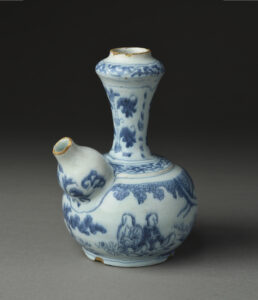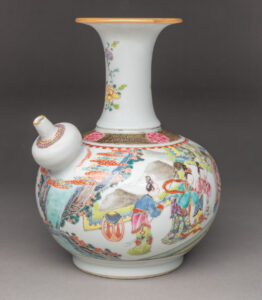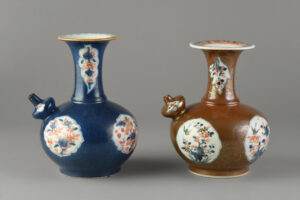
The Kendi as a Source of Worldwide Fascination
Although kendis—handle- less bottles featuring small-tipped, often bulbous spouts—are not a form common to European and American material culture, they long have been popular in Asia. Regional names for such vessels include kondi (Sumatra), gendi (Java), kindi (Kerala, India) and the Malaysian kundikâ. Kendis were produced since antiquity in Southeast Asia. The Chinese began making them during the Tang dynasty (618-906CE) and production eventually spread to Japan and Europe. Such vessels were made in a wide range of shapes, including some animal forms, but bulbous-bodied versions with narrow necks are among the most common.

Kendis are thought to have had sanitary advantages: the domed spout, with a tiny opening, kept dust, flies, and the like, out of the container. Additionally, raising and tilting the bottle resulted in an arc of liquid that could be caught in a would-be drinker’s mouth, without the need for their lips to touch the vessel.
In Asia, kendis were used in a variety of ways:
The kendi is functional and utilitarian, being used for everyday storage, cooking as well as in spiritual ceremonies. Besides water, kendis were also used to decant wine, administer medicine, and as [altar] ware for rituals, such as pouring or sprinkling ‘holy water’ during religious ceremonies. The practice of sprinkling holy water from kendis was widely used in Hindu and Buddhist ceremonies from the 7th to the 15th centuries. The kendi is one of the eighteen sacred items carried by Buddhist pilgrims, and Buddhist statues of Avalokitesvara and Maitreya (the future Buddha) are depicted holding such jugs. …[In Pakistan the kendi] is still used by Muslims for ablutions before praying. The pots were also used to ward off evil and given as wedding gifts. …
(Karen Loh, “Kendi,” Jabatan Muzium Malaysia, Kuala Lumpur, Dec. 16, 2019)
Rather than for ritual purposes, kendis made in or imported into Christian Europe likely were used ornamentally or for alcoholic beverage consumption.

It is unclear which market was the destination of a Chinese junk that sank in the South China Sea around 1643, but the vessel carried blue and white kraakporselain kendis including the Winterthur example. Chinese export kendis were made available to wealthy Europeans by the Dutch East India Company, and examples with gilt or silver mounts are portrayed in seventeenth-century Dutch paintings such as Pieter Gerritsz van Roestraten’s “Sumptuous Still Life with Lobster, Oysters, Silvergilt Covered Beaker, Silver Mounted Kendi Wine Flask and Glassware” (see Sam Segal, A Prosperous Past, 1988).
In a time before successful production of porcelain there, Europe’s fascination with the exotic Asian vessel form inspired creation of a range of imitations. Winterthur’s wonderful and diminutive seventeenth-century Dutch Delft kendi was acquired from Aronson Antiquairs, and the ornament imitates figural designs on Chinese porcelain. In contrast, beautiful kendis that were produced in the early 1700s by Böttger at Meissen in Germany were inspired by Chinese (Yixing) unglazed red stoneware.

Gift of Daniel and Serga Nadler 2014.0016.010, .011
The Chinese porcelain kendi in displays scenes of figures in outdoor settings with flowers. The painting style and so-called famille rose enamel color palette helps date the vessel to the 1740s. Perhaps made slightly earlier, the powdered-dark-blue and “Batavia” (brown ground) kendis have lost most of the gilt scrollwork and floral patterns that originally graced their solid grounds. Happily, the Imari-style reserves survive in good condition. All four of the Chinese export kendis discussed here represent types that primarily were intended for non-Christian Malaysian, Philippine, Indian, or Persian markets. That said, the ornament upon them had worldwide appeal and is identical to types on Chinese porcelain created for Europe and its colonial markets.
Text by:
Mrs. Leslie B. Grigsby, Senior Curator of Ceramics & Glass, Winterthur Museum, Library & Garden, Winterthur Delaware



